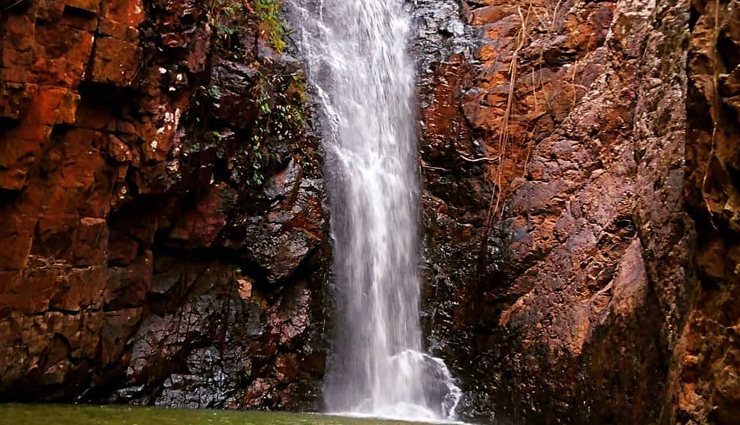10 Waterfalls You Can Explore In Odisha
By: Priyanka Maheshwari Sat, 20 July 2024 4:48:20

Odisha is renowned for safeguarding the largest expanse of forest land in India, home to a diverse array of plant and animal species, as well as captivating waterfalls. The state’s tourism industry has flourished due to its natural allure, gaining global recognition.
Among its many attractions, Odisha's waterfalls stand out as particularly enchanting for both local and international visitors. Whether under the bright sun or cloudy skies, these waterfalls provide a delightful experience.

# Badaghagara Waterfall
This waterfall remains active year-round and is part of the Machha Kandana River. It cascades from a height of sixty meters and is situated nine kilometers from Kandahar district headquarters. It is linked to the smaller Sanaghagara Waterfall, which begins three kilometers upstream.

# Duduma Waterfall
A spectacular horsetail waterfall, Duduma drops from a height of 175 meters and consists of two sub-waterfalls, one in Koraput district, Odisha, and the other in Visakhapatnam, Andhra Pradesh. Created by the Machkund River, it is a revered pilgrimage site. Surrounded by dense deciduous forests, it appears as a gateway to paradise. A dam with six units and a capacity of 120 megawatts of electricity has been constructed here. It is located approximately 92 km from Koraput and 177 km from Visakhapatnam.

# Barehipani Waterfall
The second-highest waterfall in India, Barehipani cascades from 400 meters and is a perennial stream, flowing throughout the year. Located in Similipal National Park, it is a prime tourist destination. The waterfall is fed by the Budhabalanga River and the surrounding park is home to 1,076 plant species, including 96 orchid species, and a diverse array of fauna, including tigers, giant squirrels, leopards, Asian elephants, 242 bird species, and 30 reptile species.

# Harishankar Waterfall
Named after the nearby 14th-century Harishankar Temple, this waterfall is a significant pilgrimage site. Located in the Gandhamardan Hills, south of Rourkela, the temple features a large statue of Lord Hanuman and a dancing statue of Lord Ganesha. The closest town to visit is Jharsuguda, with nearby attractions including Ispat Nehru Park, Indira Gandhi Park, and Hanuman Vatika.

# Khandadhar Waterfall
Khandadhar, a horsetail waterfall, plunges from a height of 244 meters, making it the 12th highest waterfall in India. Situated in Sundergarh district, it is best visited during the post-monsoon season. Named after the goddess Khand Kumari, it emerges from a deep ravine and serves as a water source for the Pauri Bhuliyas tribe.

# Pradhanpat Waterfall
Located in Deogarh, this waterfall descends from a height of 9.1 meters and produces soothing echo sounds. It is an excellent spot for photography due to its lush surroundings. The steep hills, the waterfall, and the dense forest make it ideal for picnics, and nearby temples offer additional sightseeing opportunities.

# Nrusinghanath Waterfall
Named after the nearby Nrusinghanath Temple, this waterfall is located at the foothills of Gandhamardan Hill in Bargarh District. Surrounded by dense forest and hilly terrain, it is best visited between October and March. Several smaller waterfalls, including Gadadhar, Pitrudhar, and Chaladhar, are found around the Nrusinghanath Temple.

# Handibhanga Waterfall
Situated in Bahalada Village, Keonjhar District, Handibhanga Waterfall flows from a height of 30 meters. The best time to visit is between October and March. It is located near the popular Sanghaghra Waterfall. Visitors can also explore the local village to learn about tribal cultures and traditions, with Indian Gaurs commonly seen in the surrounding forest.

# Phurlijharan Waterfall
Located in Karlapat Wildlife Sanctuary, Kalahandi District, Phurlijharan Waterfall is 15 kilometers from Bhawanipatna. With a height of 9.1 meters, it creates a beautiful rainbow on sunny days. The ideal time to visit is from September to January.

# Murga Mahadev Waterfall
Named after the adjacent Murga Mahadev Temple, this waterfall is especially vibrant during the festivals of Kartika, Shravana, and Shivratri. The best time to visit is between October and March when the weather is pleasant. It is a popular picnic spot, dropping from a height of 30 feet and is a perennial waterfall.





